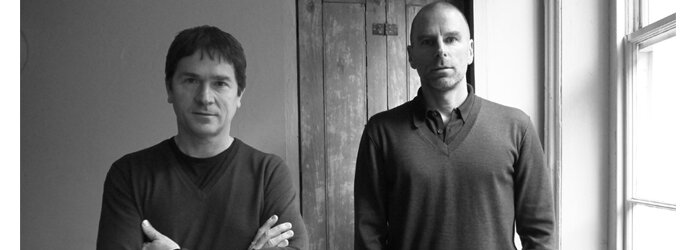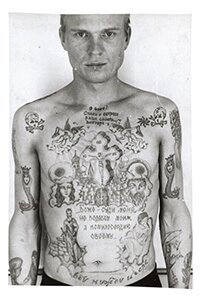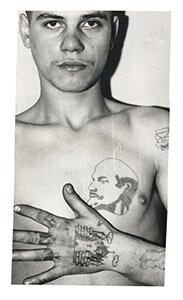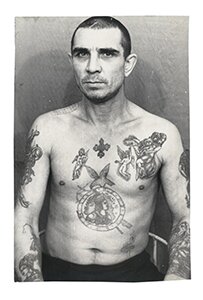Grimaldi Gavin gallery’s latest exhibition displays Arkady Bronnikov’s collection of photographs of Russian prisoner tattoos found between the mid 1960s until 1980s. In 2013, the selection of photographs were acquired by FUEL, publishing two volumes of The Bronnikov Collection. With 918 images included, the collection forms a representation of a guileless criminal society. In celebration of its release and exhibition, Ultra Vie had the opportunity to interview Damon Murray and Stephen Sorrell from FUEL for an insight of their latest publication.
Could you please tell us more about the Russian Criminal Tattoo Archive?
consists of photographs and drawings we’ve been collecting since 2003. Essentially it comprises the work of three people: Danzig Baldaev who during his time as a prison guard between 1948 and 1986 made over three thousand drawings of criminals tattoos. Tattoos were his gateway into a secret world in which he acted as ethnographer, recording the rituals of a closed society. The icons and tribal languages he documented are artful, distasteful, sexually explicit and provocative, reflecting as they do the lives and traditions of convicts. The accompanying photographs by Sergei Vasiliev was a newspaper photographer who visited prisons and camps on his own initiative to document the inmates lives. His images act as an important counterpart to Baldaev’s drawings, providing photographic evidence of their authenticity, and allowing us a glimpse into this compelling and extraordinary world. Arkady Bronnikov was a criminalistics expert who took and collected photographs of criminals in an attempt to understand and categorise the phenomenon of the criminal tattoo. His photographic collection is a vernacular survey confirming that the police recognised the importance of these symbols. In these incredible images the nameless bodies of criminals act as both a text and mirror, reflecting and preserving the ever-changing folklore of the Russian criminal underworld. In addition to these three core bodies of work, the archive contains filmed interviews, records of exhibitions held to date, and is a place where people can buy the best-selling books Russian Criminal Tattoo Encyclopaedia (Volumes I-III) and Russian Criminal Tattoo Police Files (which is exclusive to the website).
What interests you in collecting criminal tattoo police files?
Ironically, we were originally drawn to Russian criminal tattoos because of their honesty. These tattoos, if you are able to decipher their code, can tell you the history of the person wearing them. Today tattoos are fashionable, worn by pop-stars and footballers, they carry little meaning to anyone else but the person wearing them, making them introspective or merely decorative. By contrast, the Russian criminal tattoos may be a coded language, but they are still a statement that is intended to be read and understood as a projection of the bearers status and history in the criminal world. Criminals had to earn their tattoos, they had to reflect the truth about their crimes. If they didn’t they were given a piece of glass or a brick and told to remove the tattoo or face the consequences. It is the attempt to understand the dynamics behind the importance placed on these marks that makes the subject so interesting for us. The images in the Police Files series are particularly compelling because the collection was made exclusively for police use, to further the understanding of the language of these tattoos and to act as an aid in the identification and apprehension of criminals in the field. The photographer’s only consideration was the recording of the body for practical purposes. Unimpeded by artistry, these vernacular photographs present a guileless representation of criminal society.
Having studied 918 images of The Bronnikov collection, what exactly is the language of these tattoos of Russian prisoners?
Each tattoo is a statement about that inmate’s position within the prison and criminal society as a whole. As soon as a normal inmate enters the mass population of the ‘zone’ (either a prison or a camp), they realise that the thieves are in charge. They copy both their tattoos and mannerisms in an attempt to elevate their status. For self-protection they need to show themselves to be exceptional, experienced, brave and seasoned men. In addition to fear, respect and the obedience of friends, their tattoos are intended to demonstrate a desire for self-assertion and the conquest of authority in the criminal environment. Within the ‘language’ itself the original connotation of any symbol might be distorted or completely contrary to that outside the criminal world. For example, Lenin is held by many criminals to be the chief pakhan (boss) of the Communist Party. The letters BOP, which are sometimes tattooed under his image, carry a double meaning. The acronym stands for ‘Leader of the October Revolution’ but also spells the Russian word VOR (thief). Often tattoos with portraits of Lenin and Stalin are intended to show patriotic feelings. However, some prisoners had portraits of Lenin and Stalin tattooed on their chest for ‘protection’, as it was commonly believed that the guards were forbidden to shoot at an image of their great leaders.
Throughout the process, how did your understanding and impressions of a criminals’ character change?
The life of a Russian criminal was brutal, unforgiving and is practically impossible for us to grasp. They followed their own laws, any transgressions of which were punished severely, even fatally. Although they present a seemingly impenetrable façade, the tattoos allow us some small insight. The tiny fraction of prisoners documented here unintentionally betray their human side. Every image discloses evidence of an inmate’s character: aggressive, vulnerable, melancholic, conceited. Their bodies display an unofficial history, told not just through tattoos, but also in scars and missing digits. Closer inspection only confirms our inability to comprehend the unimaginable lives of this previously unacknowledged caste.
What can readers expect from FUEL’s new volumes about this phenomenon?
are an essential companion to the Russian Criminal Tattoo Encyclopaedia series as they employ clinical, forensic approach, reflecting the Arkady Bronnikov’s career as a police officer and later a professor of criminalistics at the Perm Faculty of the Academy of the Ministry of Internal Affairs. The writing is based around his documentation of the subject during his time in the police force, while the images lend a veracity to this text, confirming the unquestionable authenticity of both.
The Russian Criminal Tattoo Police Files book is available exclusively in the FUEL Website:
 LIVE FEEDS
LIVE FEEDS





 OLIVIA COLMAN PORTRAIT | NEW PORTRAIT UNVEILED AT NATIONAL PORTRAIT GALLERY
OLIVIA COLMAN PORTRAIT | NEW PORTRAIT UNVEILED AT NATIONAL PORTRAIT GALLERY
 IFPDA PRINT FAIR 2014 | THE ART FAIR FOR OLD MASTER AND CONTEMPORARY PRINTS
IFPDA PRINT FAIR 2014 | THE ART FAIR FOR OLD MASTER AND CONTEMPORARY PRINTS
 WEEKLY ART NEWS | THE WEEK IN PICTURES
WEEKLY ART NEWS | THE WEEK IN PICTURES
 WORLD PRESS PHOTO EXHIBITION | THE ANNUAL PRESS PHOTOGRAPHY COMPETITION
WORLD PRESS PHOTO EXHIBITION | THE ANNUAL PRESS PHOTOGRAPHY COMPETITION
 FRIEZE ART FAIR: THE COLLECTOR | AN INTERVIEW WITH ROBIN BROWN
FRIEZE ART FAIR: THE COLLECTOR | AN INTERVIEW WITH ROBIN BROWN
